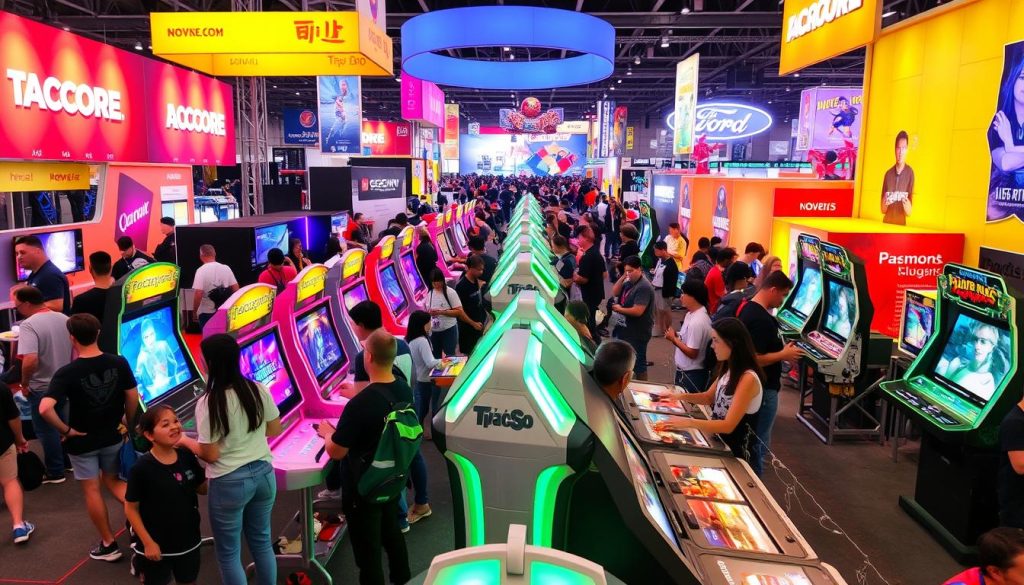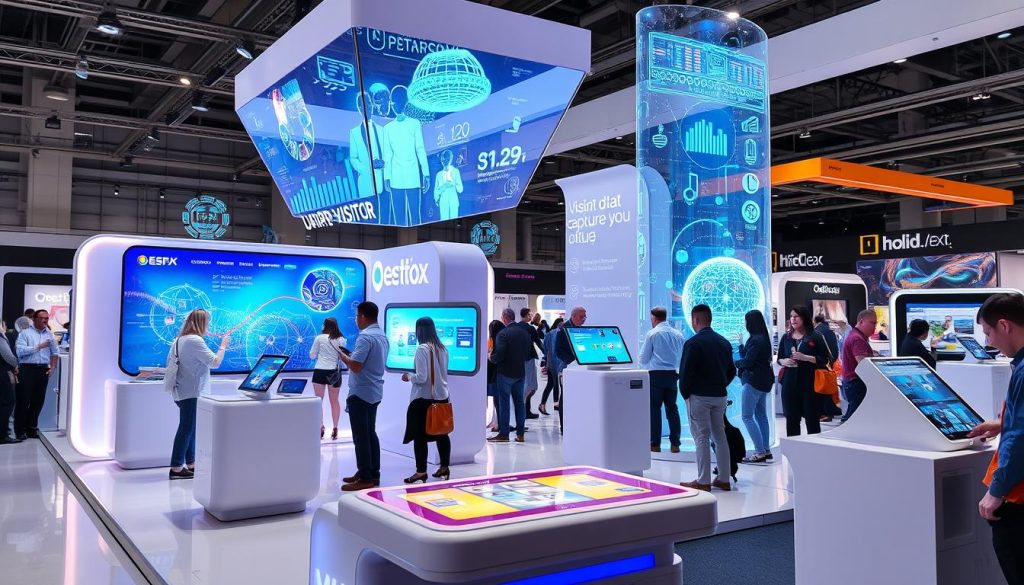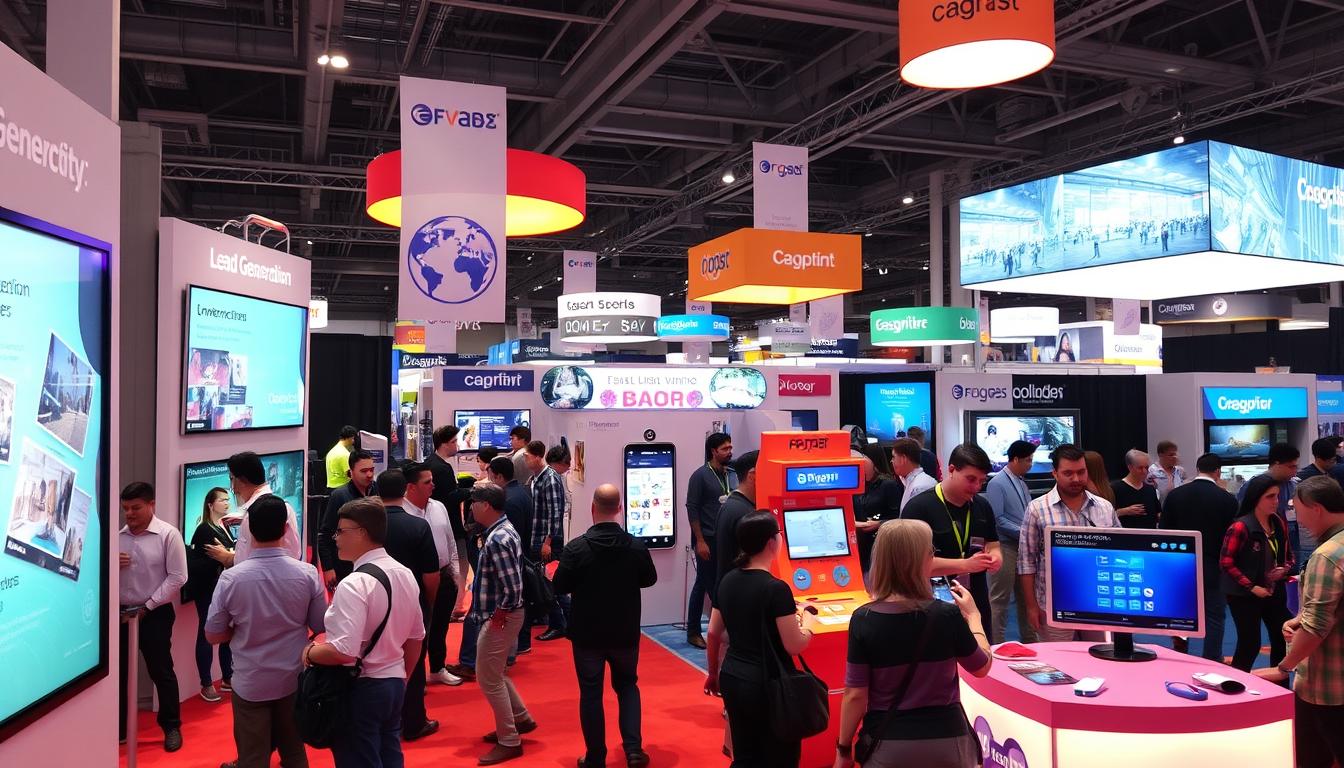Expos offer a golden opportunity to turn visitors into valuable leads. By tapping into the power of interactive exhibits and gamification, businesses can create engaging experiences that leave lasting impressions. These dynamic strategies not only capture attention but also drive meaningful connections with potential clients.
Interactive displays and games at expos serve as powerful tools for lead generation. They break the ice, making it easier for visitors to approach and interact with your brand. By offering a fun and memorable experience, you’re more likely to stand out in a sea of traditional booths.
Gamification takes this concept a step further. It transforms the expo experience into an enjoyable challenge, encouraging visitors to engage more deeply with your brand. Whether it’s a digital quiz or a physical game, these interactive elements can significantly boost your lead conversion rates.
Key Takeaways
- Interactive exhibits boost visitor engagement
- Gamification enhances lead generation strategies
- Memorable experiences lead to stronger brand connections
- Fun challenges encourage deeper visitor interactions
- Interactive elements help businesses stand out at expos
- Games and quizzes can significantly improve lead conversion
Understanding the Expo Visitor Journey Map
Trade show marketing is all about visitor engagement. To maximize success, it’s crucial to understand how expo attendees navigate and interact with exhibits. Let’s explore the visitor journey map and uncover key insights for effective trade show strategies.
Initial Touchpoints and Visitor Psychology
First impressions matter at expos. Visitors often make split-second decisions about which booths to visit. Eye-catching displays and friendly staff can draw people in. Engaging conversations are vital for sparking interest and building connections.
Decision-Making Patterns at Trade Shows
Expo attendees typically follow specific patterns when deciding which exhibits to explore. They may prioritize booths related to their interests or seek out innovative products. Understanding these patterns helps optimize booth placement and design for maximum visitor engagement.
Behavioral Triggers That Drive Engagement
Certain triggers can boost interaction at trade shows. Interactive displays, product demos, and exclusive offers often entice visitors. Gamification elements can also enhance engagement, turning passive observers into active participants.
| Engagement Trigger | Impact on Visitor Behavior | Implementation Strategy |
|---|---|---|
| Interactive Displays | Increases booth dwell time | Use touchscreens or VR experiences |
| Product Demos | Builds product understanding | Schedule regular live demonstrations |
| Exclusive Offers | Creates urgency and interest | Provide show-only discounts or trials |
| Gamification | Encourages active participation | Implement booth challenges or quizzes |
By mapping the expo visitor journey and leveraging these insights, businesses can create compelling trade show experiences that drive meaningful engagement and convert interactions into valuable leads.
The Power of Interactive Exhibits in Lead Generation
Interactive exhibits are game-changers in the world of lead generation. These dynamic displays captivate expo visitors, turning passive observers into engaged prospects. By offering hands-on experiences, interactive exhibits create memorable moments that stick with attendees long after the event ends.
Expo organizers are increasingly embracing technology to boost engagement. Touch screens, virtual reality simulations, and augmented reality displays are becoming commonplace. These tools not only attract attention but also improve lead conversion rates by providing valuable data on visitor interests and behaviors.
The impact of interactive exhibits on lead generation is significant. Studies show that booths with interactive elements see up to 70% more foot traffic than static displays. This increased engagement translates directly into more leads and potential sales opportunities.
“Interactive exhibits don’t just attract visitors; they create conversations and build relationships. That’s the real power behind effective lead generation at expos.”
To maximize the potential of interactive exhibits, consider these strategies:
- Design exhibits that align with your brand message
- Incorporate gamification elements to encourage participation
- Use data capture tools to gather visitor information seamlessly
- Follow up promptly with leads generated from interactive experiences
By leveraging the power of interactive exhibits, businesses can transform their expo presence from a static display into a dynamic lead generation machine. The key lies in creating engaging experiences that resonate with visitors and provide value beyond the initial interaction.
From Game to Client: How Expo Games Convert Visitors into Leads
Expo games are powerful tools for turning casual visitors into valuable leads. By tapping into the psychology of play, businesses can create engaging experiences that naturally guide potential clients through the sales funnel. Let’s explore the magic behind how expo games convert visitors into leads and the role of gamification in this process.
Game Mechanics That Drive Lead Conversion
Effective expo games use specific mechanics to capture visitor information and interest:
- Progress bars: Encourage completion of tasks
- Leaderboards: Spark competitive spirit
- Challenges: Offer rewards for participation
- Quizzes: Gather data while educating visitors
Incorporating Brand Messages Into Gaming Elements
Smart brands weave their core messages into game elements. This subtle approach reinforces brand identity while keeping players engaged. For example, a tech company might create a puzzle game where each solved level reveals a product feature.
Measuring Gaming Success Metrics
To gauge the effectiveness of expo games in lead generation, track these key metrics:
| Metric | Description | Target |
|---|---|---|
| Participation Rate | Percentage of booth visitors who play | 70%+ |
| Completion Rate | Players who finish the game | 80%+ |
| Lead Capture Rate | Players who provide contact info | 60%+ |
| Follow-up Engagement | Leads who respond post-expo | 30%+ |
By focusing on these elements, businesses can create expo games that not only entertain but also effectively convert visitors into leads. The key is to balance fun with strategic brand messaging, ensuring a memorable experience that prompts further engagement.
Creating Memorable Brand Experiences Through Gamification
Gamification transforms expo booths into captivating brand experiences. By blending digital and physical elements, companies craft unforgettable interactions that resonate with visitors long after the event ends.
Digital vs Physical Gaming Experiences
Digital games offer scalability and data collection advantages. Physical games provide tangible, immersive experiences. Striking the right balance depends on your audience and objectives.
| Digital Games | Physical Games |
|---|---|
| Easy to update | Tactile engagement |
| Collect user data | Social interaction |
| Global accessibility | Unique sensory experience |
Customizing Games for Different Industry Sectors
Tailoring games to specific industries enhances relevance and engagement. A finance company might create a budget-balancing challenge, while a tech firm could design a coding puzzle. Effective lead generation strategies often involve industry-specific gamification.

Reward Systems That Drive Engagement
Thoughtful reward systems turn casual visitors into leads. Consider these options:
- Point systems with leaderboards
- Exclusive content unlocks
- Branded merchandise prizes
- Discount codes for products or services
By integrating these elements, you create brand experiences that captivate and convert. Gamification turns passive observers into active participants, fostering connections that extend beyond the expo floor.
Building Effective Sales Funnels at Trade Shows
Trade show marketing offers a unique opportunity to create powerful sales funnels. By understanding visitor behavior, you can guide potential clients through each stage of the buying process. Let’s explore how to build an effective sales funnel at your next expo.
The first step in crafting a successful sales funnel is attracting visitors to your booth. Eye-catching displays and interactive elements draw people in. Once they’ve stopped by, engage them with a quick pitch or demo that highlights your product’s key benefits.
Next, focus on lead capture. Use digital tools to collect contact information and qualify leads on the spot. This data becomes crucial for follow-up efforts after the show. Omnily.io CRM can help streamline this process, ensuring no potential client falls through the cracks.
After the event, nurture your leads with targeted content and personalized outreach. Use the insights gathered at the trade show to tailor your approach. Remember, the sales funnel doesn’t end when the expo does – it’s just beginning.
“Trade shows are a goldmine for sales opportunities. The key is to turn those brief interactions into lasting relationships.”
To maximize your trade show ROI, consider these tactics:
- Offer exclusive show-only deals to create urgency
- Use social proof by showcasing customer testimonials
- Provide valuable content that addresses common pain points
- Follow up promptly with personalized messages
| Funnel Stage | Trade Show Strategy | Post-Show Action |
|---|---|---|
| Awareness | Eye-catching booth design | Social media engagement |
| Interest | Product demos | Educational content |
| Consideration | One-on-one consultations | Case studies |
| Decision | Show-exclusive offers | Personalized proposals |
By implementing these strategies, you’ll create a seamless sales funnel that converts expo visitors into loyal customers. Remember, the goal is to stand out in a sea of competitors and make lasting connections that drive business growth.
Leveraging Technology for Visitor Data Capture
In today’s digital age, expo organizers are harnessing cutting-edge technology to boost lead generation and visitor engagement. By utilizing advanced tools, businesses can gather valuable data while ensuring a seamless experience for attendees.

Digital Tools for Lead Tracking
Modern expos employ a range of digital tools to track leads effectively. QR code scanners, RFID wristbands, and mobile apps streamline the process of collecting visitor information. These technologies enable quick and accurate data capture, allowing exhibitors to focus on meaningful interactions with potential clients.
Integration with CRM Systems
To maximize the value of collected data, seamless integration with Customer Relationship Management (CRM) systems is crucial. This integration allows for real-time lead generation and immediate follow-up actions. By syncing visitor data with CRM platforms, businesses can nurture leads more effectively and improve conversion rates.
Privacy Compliance in Data Collection
While gathering visitor data is essential for successful lead generation, it’s equally important to prioritize privacy compliance. Expo organizers must adhere to data protection regulations like GDPR and CCPA. Implementing transparent data collection practices and obtaining explicit consent from visitors builds trust and ensures legal compliance.
By leveraging these technological solutions, businesses can enhance visitor engagement and create more personalized experiences. This approach not only improves lead quality but also sets the stage for long-term customer relationships, ultimately driving business growth in the competitive expo landscape.
Experiential Marketing Strategies That Convert
Experiential marketing creates lasting impressions that drive lead generation at expos. By engaging visitors’ senses, brands can forge emotional connections that traditional methods often miss. This approach transforms passive observers into active participants, boosting conversion rates.
One effective strategy is the creation of immersive brand environments. These spaces tell your brand’s story through interactive displays, cutting-edge technology, and sensory experiences. Visitors don’t just learn about your product; they live it.
Virtual reality (VR) demos offer another powerful tool. They transport expo attendees to virtual worlds where they can explore products in lifelike scenarios. This hands-on experience builds trust and excitement, turning curious visitors into qualified leads.
Live product demonstrations remain a cornerstone of experiential marketing. When done right, they showcase your offering’s unique value proposition in an engaging, memorable way. The key is to make these demos interactive, allowing visitors to test and experience the product themselves.
| Strategy | Lead Generation Impact | Implementation Difficulty |
|---|---|---|
| Immersive Brand Environments | High | Medium |
| VR Demos | Very High | High |
| Interactive Product Demonstrations | High | Low |
Remember, the goal of experiential marketing is to create a lasting impression that converts into tangible business results. By focusing on engagement and interactivity, you can turn expo visitors into valuable leads and loyal customers.
Optimizing Booth Design for Maximum Engagement
A well-designed expo booth can make a world of difference in visitor engagement and lead generation. Smart booth design goes beyond aesthetics, focusing on creating an inviting space that draws people in and keeps them interested.
Traffic Flow Optimization
Efficient traffic flow is key to a successful booth. Design your space with clear pathways and strategically placed interactive exhibits. This approach allows visitors to explore freely without feeling crowded or overwhelmed.
Visual Elements That Attract
Eye-catching visuals are crucial for standing out on a busy expo floor. Use bold colors, striking graphics, and unique shapes to grab attention. Remember, your booth should tell your brand story at a glance.
Interactive Technology Integration
Incorporating interactive technology can significantly boost visitor engagement. Touch screens, virtual reality experiences, and interactive product demos give attendees hands-on interaction with your brand. These elements not only educate but also create memorable experiences that can lead to lasting connections.






